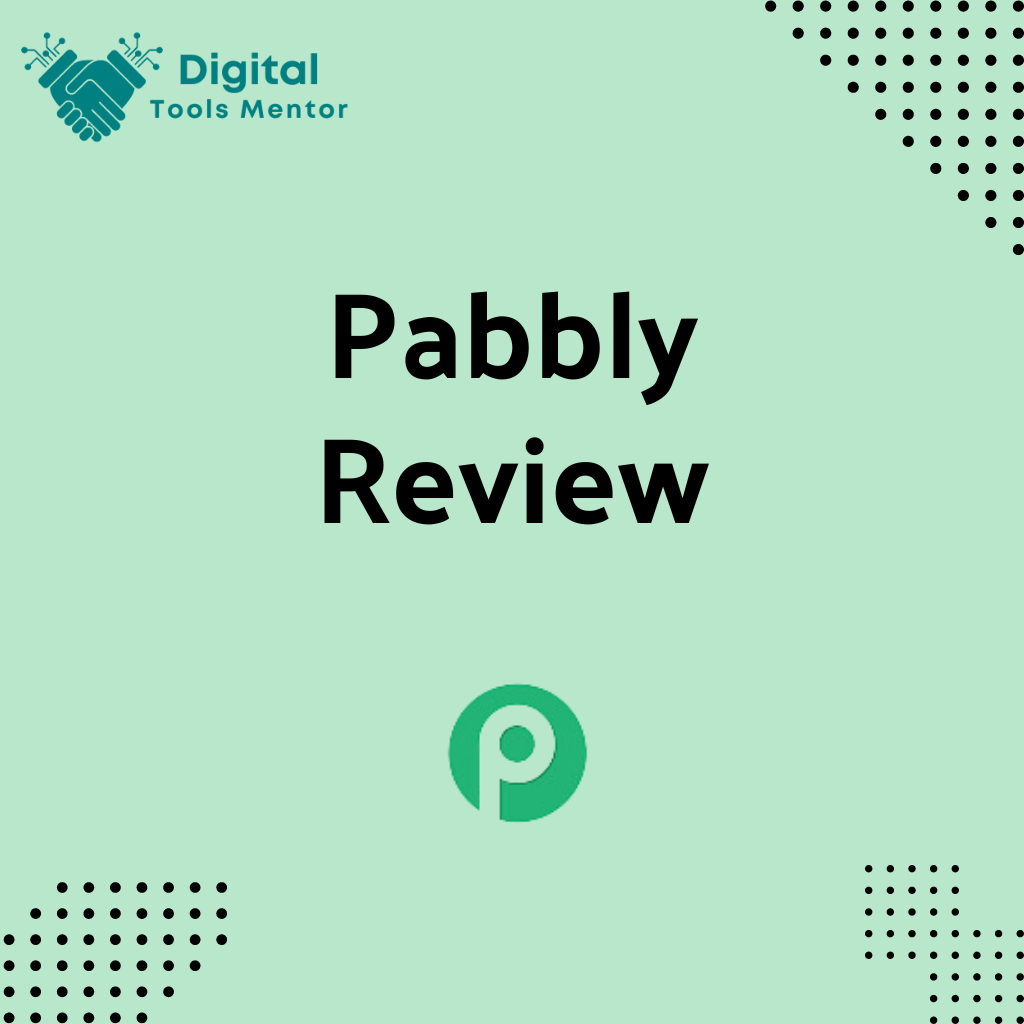Pabbly Review 2025
In the bustling digital ecosystem, where businesses seek streamlined solutions to manage their operations efficiently, Pabbly emerges as a beacon of integrated business tools. This comprehensive suite, known for its robust features in subscription billing, email marketing, form creation, and more, offers a unified platform designed to automate and simplify complex business processes. As we delve into Pabbly, it becomes evident why this software is gaining traction among small to medium-sized businesses and why it’s considered a significant player in the market.
Overview of Pabbly
Pabbly is a unique, all-in-one platform that provides businesses with a multitude of services, including but not limited to, automated billing, subscription management, email marketing campaigns, and seamless workflow integrations. What makes Pabbly stand out is its commitment to providing a comprehensive toolset without the need for multiple subscriptions or integrating disparate systems. This approach not only saves time and resources but also enhances operational efficiency by keeping all essential business functions under one roof.
Significance in the Market
In today’s competitive landscape, Pabbly distinguishes itself by offering a no-code solution that caters to the diverse needs of businesses looking to scale. With a keen understanding of the challenges faced by small to medium enterprises, Pabbly provides an affordable, user-friendly platform that eliminates the need for extensive technical knowledge or a large IT department. This democratization of business tools allows companies of all sizes to leverage powerful automation and management features, leveling the playing field in various industries.
Initial Impressions and Unique Offerings
Upon first glance, Pabbly impresses with its sleek interface and intuitive design, making it accessible to users of all skill levels. What truly sets Pabbly apart from its competitors, however, is its transparent pricing model. Unlike other platforms that charge extra for each add-on service or feature, Pabbly offers unrestricted access to all its tools under a single subscription fee. This not only simplifies budgeting for businesses but also ensures that they can fully utilize the suite’s capabilities without worrying about additional costs.
Moreover, Pabbly’s commitment to continuous improvement and customer satisfaction is evident in its regular updates and the addition of new features based on user feedback. This customer-centric approach, combined with its comprehensive suite of tools, makes Pabbly a standout solution for businesses aiming to optimize their operations and drive growth.
In conclusion, Pabbly is not just another software in the market; it is a versatile platform that empowers businesses with the tools they need to manage their operations efficiently. With its unique offerings, transparent pricing, and a focus on user experience, Pabbly is well-positioned to help businesses overcome challenges and achieve their strategic goals.
Comprehensive Overview of Pabbly Features
Pabbly stands out in the crowded field of business tools by offering a rich array of features designed to automate and streamline critical operations. From subscription management to email marketing, form building, and comprehensive automation tools, Pabbly equips businesses of all sizes with the capabilities they need to thrive in a digital environment. Let’s dive into the details of these key features and understand the benefits they bring.
Subscription Management
Feature Description: Pabbly’s subscription management tool simplifies the process of managing recurring billing and subscriptions. It automates invoicing, payment processing, and subscription tracking, making it easier for businesses to maintain consistent revenue streams.
Benefits for Businesses: Small businesses can benefit from reduced administrative workload and improved cash flow management. Larger enterprises will appreciate the scalability of the tool, allowing them to manage a growing number of subscriptions efficiently. The automated system minimizes errors and ensures a smooth billing process for both the business and its customers.
Email Marketing
Feature Description: The email marketing feature of Pabbly allows businesses to create, send, and track email campaigns with ease. It offers a range of customizable templates, segmentation capabilities, and detailed analytics to optimize email marketing strategies.
Benefits for Businesses: Businesses can engage with their audience on a personal level, increasing brand loyalty and customer retention. The analytics provided help in understanding the effectiveness of campaigns, enabling businesses to tweak their strategies for better results. Small to medium-sized businesses will find the intuitive design and cost-effectiveness particularly beneficial, allowing them to compete with larger companies in their marketing efforts.
Form Building
Feature Description: Pabbly’s form builder is a powerful tool that enables businesses to create custom forms for various purposes, such as lead generation, surveys, and feedback collection. It offers drag-and-drop functionality, a wide range of field types, and integration capabilities.
Benefits for Businesses: The form builder enhances customer engagement by making it easy to collect valuable information and insights. It supports businesses in data-driven decision-making and improves service offerings based on customer feedback. The simplicity of the tool allows businesses of any size to create professional-looking forms without needing technical expertise.
Automation Tools
Feature Description: Pabbly Connect, the platform’s automation tool, allows businesses to automate workflows between different apps and services. It supports hundreds of integrations, enabling tasks like data transfer, event triggering, and action execution without manual intervention.
Benefits for Businesses: Automation saves time and reduces errors, significantly increasing operational efficiency. Businesses can automate routine tasks, freeing up resources to focus on strategic activities. This feature is particularly beneficial for scaling businesses that need to manage increasing workloads without proportionally increasing their overheads.
Additional Benefits Across Features
- Centralization: Pabbly’s suite offers a centralized platform for managing multiple business operations, reducing the need for multiple tools and subscriptions.
- Cost-Effectiveness: With a transparent pricing model, businesses can access all features without worrying about additional costs, making it an affordable solution for growing businesses.
- Scalability: Pabbly grows with your business. Its features are designed to handle increasing demand, making it a long-term solution for businesses planning to expand.
In conclusion, Pabbly provides a comprehensive set of tools that cater to the diverse needs of businesses in today’s digital landscape. Its subscription management, email marketing, form building, and automation tools not only streamline operations but also drive growth by enhancing engagement and improving efficiency. Whether you’re a small startup or a large enterprise, Pabbly offers scalable, cost-effective solutions that can transform your business operations.
Ease of Use and User Interface
Pabbly stands out in the crowded field of business automation tools not just for its comprehensive features but also for its dedication to user experience. The platform’s design philosophy centers around simplicity and efficiency, ensuring that businesses can leverage its powerful suite of tools without getting bogged down by complexity. This commitment to ease of use and a user-friendly interface is evident from the moment you log into Pabbly.
User Interface and Ease of Navigation
The Pabbly dashboard presents a clean, intuitive layout that immediately puts users at ease. Navigation is straightforward, with clearly labeled sections for each of its core features, such as subscription management, email marketing, form building, and automation tools. This thoughtful organization allows users to quickly find the functionalities they need without unnecessary clicks or confusion.
The design aesthetic is modern and uncluttered, contributing to an environment that minimizes distractions and focuses on productivity. Whether you’re setting up a new email campaign, creating a subscription model, or building a form, Pabbly ensures that the tools you need are always just a few clicks away.
Learning Curve for New Users
For new users, Pabbly offers a gentle learning curve, thanks in part to its comprehensive knowledge base and a plethora of tutorial videos. These resources are designed to help users familiarize themselves with the platform’s capabilities, guiding them through basic tasks to more advanced functionalities.
However, like any robust platform, mastering Pabbly’s full suite of tools will take some time and experimentation. The complexity of tasks you can accomplish with Pabbly means there’s a depth to explore, but the platform makes this journey manageable. New users can start leveraging many of Pabbly’s features right away, gradually deepening their understanding as they explore more of the platform’s capabilities.
Quality of User Experience
The overall user experience with Pabbly is highly positive. The platform runs smoothly, with quick loading times and responsive design elements, ensuring that tasks can be completed efficiently. Pabbly’s user interface strikes an excellent balance between functionality and aesthetics, making daily operations not just productive but also visually pleasing.
Feedback from users is taken seriously, with the Pabbly team regularly implementing updates and improvements based on user suggestions. This dynamic approach to development means that the platform evolves in ways that directly benefit its user base, enhancing the overall quality of the user experience over time.
In conclusion, Pabbly’s focus on ease of use and a user-friendly interface significantly lowers the barrier to entry for businesses looking to adopt automation tools. Its straightforward design, combined with extensive support resources, ensures that businesses of all sizes can improve their operations without the need for extensive technical expertise. Pabbly not only empowers users with powerful tools but does so in a way that is accessible and enjoyable to use.
Integration Capabilities
In the digital age, where businesses rely on a myriad of tools and platforms to operate, the ability to integrate these systems seamlessly is invaluable. Pabbly stands out in this regard, offering robust integration capabilities that enable businesses to connect their various software solutions, thereby streamlining processes and enhancing productivity. This connectivity is a cornerstone of Pabbly’s value proposition, allowing for a more efficient and cohesive digital workflow.
Overview of Pabbly’s Integration Options
Pabbly provides a wide array of integration options through its native connectors and via Pabbly Connect, a platform designed to automate workflows between different apps without requiring any coding skills. With support for hundreds of popular applications across categories such as CRM systems, email marketing platforms, payment gateways, ecommerce, and more, Pabbly ensures that businesses can easily link their existing software infrastructure.
Key integration highlights include connections with major services like Salesforce, Shopify, Stripe, PayPal, WordPress, and Zapier. This extensive list ensures that whether a business needs to automate sales processes, manage customer relationships, handle transactions, or conduct email marketing campaigns, Pabbly can integrate these tasks into a unified workflow.
Streamlining Business Processes
The integration capabilities offered by Pabbly are designed with the end goal of streamlining business processes. By allowing different software systems to communicate and share data automatically, Pabbly eliminates the need for manual data entry, reduces the likelihood of errors, and saves valuable time. For instance, a new sale on an ecommerce platform can trigger an automatic invoice generation in an accounting software, update the customer record in a CRM system, and initiate a targeted email marketing campaign, all without any human intervention.
Enhancing Productivity
Pabbly’s integration capabilities significantly enhance productivity by automating routine tasks, which frees up team members to focus on more strategic initiatives. This automation is particularly beneficial for small to medium-sized businesses, where resources are often limited. By optimizing workflows and reducing manual workload, businesses can achieve more with less, improving their operational efficiency and scaling their growth more effectively.
Moreover, the data synchronization across platforms ensures that all departments have access to up-to-date information, enabling better decision-making and a more cohesive team dynamic. The ability to customize workflows and set up conditional logic means that businesses can tailor their automation processes to fit their unique needs, further enhancing productivity.
In conclusion, Pabbly’s integration capabilities are a powerful asset for businesses looking to automate and optimize their operations. By providing seamless connectivity between a wide range of software tools and platforms, Pabbly not only simplifies workflow management but also unlocks new possibilities for productivity and efficiency. This interconnected ecosystem is a testament to the potential of integrated digital workflows to transform business operations.
Pabbly’s Pricing Structure Overview
Pabbly offers a comprehensive suite of tools, and its pricing structure is designed to reflect the versatility of its services, including subscription billing, email marketing, form building, and automation tools. Pabbly’s pricing often stands out for its no-per-user fees and no-feature limitations, offering full access to its capabilities within each plan, a notable departure from the tiered feature access common with other SaaS providers.
Free Tiers or Trial Periods
Pabbly has been known to offer a free trial or a limited free tier for some of its services. This approach allows potential customers to explore Pabbly’s features and user interface before committing to a paid plan. The free trial or tier typically includes basic features with limitations on usage volume, which can be upgraded to unlock full capabilities.
Subscription Plans
Pabbly’s services are usually segmented into different subscription plans, tailored to meet the varied needs of businesses from startups to large enterprises. The structure generally includes:
- Starter Plan: Designed for small businesses or those just beginning with automation and online tools. This plan usually covers a basic set of features with limitations on the volume of transactions or emails.
- Standard Plan: A step up from the Starter, offering higher volume limits and access to more advanced features. This plan is suited for growing businesses that need more from their tools but are not yet operating at a large scale.
- Professional Plan: Tailored for businesses with significant operational demands, offering higher or unlimited volumes and access to premium features, including advanced automation and integration capabilities.
- Enterprise Plan: The most comprehensive option, designed for large businesses and enterprises with specific needs. This plan often includes custom volume limits, dedicated support, and the possibility of customized features or integrations.
Comparison and Choosing the Right Plan
When comparing Pabbly’s plans, businesses should consider:
- Volume Needs: Evaluate the volume of transactions, emails, or form submissions your business handles to choose a plan that accommodates your activity without unnecessary limitations.
- Feature Requirements: Assess which Pabbly features are essential for your operations. While Pabbly prides itself on not limiting features by plan, some advanced functionalities may be more aligned with higher-tier plans.
- Budget Constraints: Align your choice with your budget, considering the ROI that each plan can offer based on the efficiencies and capabilities it introduces to your operations.
- Scalability: Consider your business growth trajectory to select a plan that not only meets current needs but can also accommodate future growth, minimizing the need for frequent plan changes.
In conclusion, Pabbly’s pricing and plans are structured to provide flexibility and scalability to businesses at different stages of growth. By offering comprehensive access to its features across all plans, Pabbly ensures that businesses of all sizes can leverage its tools to enhance their operations. Remember, for the most current pricing and plan details, checking Pabbly’s official website is the best approach.
Performance and Reliability
In the realm of digital tools where uptime, speed, and reliability are not just features but necessities, Pabbly positions itself as a robust and dependable platform. The performance metrics and reliability of Pabbly are critical to its value proposition, especially given its wide array of functionalities, from subscription management to email marketing and automation workflows. While specific numeric metrics and uptime guarantees are subject to change and can be found on Pabbly’s official communications, the platform’s overall commitment to high performance and reliability is a constant theme.
Performance Metrics and Uptime Guarantees
Pabbly has historically emphasized its commitment to providing a seamless and efficient user experience, underpinned by solid performance metrics such as quick loading times, rapid response rates for customer interactions, and efficient processing of automated tasks. These performance metrics are crucial for businesses that rely on Pabbly to manage critical operations, ensuring minimal lag and downtime.
Uptime, the percentage of time the service is available and operational, is another critical metric for any SaaS platform. Pabbly strives to maintain an impressive uptime record, often promising 99.9% availability. This commitment is vital, ensuring that businesses can depend on Pabbly’s services around the clock, minimizing potential disruptions to operations and customer interactions.
Real-world Examples and Case Studies
E-commerce Integration: An e-commerce business utilized Pabbly to streamline its operations by integrating its online store with inventory management and email marketing tools. This automation led to a significant reduction in manual workloads, allowing the team to focus on strategic tasks. The reliable performance of Pabbly ensured that the automated workflows ran smoothly, even during peak sales periods, demonstrating the platform’s ability to handle high volumes of transactions and data.
Subscription Service Scaling: A subscription-based service leveraged Pabbly for managing its growing subscriber base and automating billing processes. Pabbly’s reliable subscription management and automation tools supported the business’s scaling efforts, handling an increasing number of transactions without any degradation in performance. This case highlights Pabbly’s capacity to support business growth through reliable automation and management features.
Marketing Campaign Efficiency: Another example involves a company that used Pabbly’s email marketing tools to orchestrate and analyze its marketing campaigns. The platform’s performance in managing large volumes of emails and providing real-time analytics enabled the company to refine its strategies quickly and efficiently. The reliability of Pabbly’s email delivery system ensured high deliverability rates, contributing to the campaign’s success.
These real-world examples underscore Pabbly’s effectiveness in providing a reliable and high-performing platform that businesses can depend on for critical operations. The platform’s ability to maintain consistent performance, even under the strain of high demand, speaks to its robust infrastructure and commitment to quality.
In conclusion, Pabbly’s performance and reliability are among its key strengths, offering businesses the confidence that their operations can run smoothly and efficiently. By delivering on its uptime guarantees and providing a platform capable of handling high-demand scenarios with ease, Pabbly demonstrates its value as a cornerstone tool for businesses looking to streamline their processes and scale their operations.
Pros and Cons of Pabbly
Pabbly, a versatile suite of business tools designed to streamline operations from email marketing to subscription management, has garnered attention for its comprehensive features and user-friendly approach. Like any platform, however, it presents a mix of strengths and areas for improvement. An honest assessment of Pabbly’s pros and cons can help potential users make an informed decision tailored to their specific business needs.
Pros
- Comprehensive Feature Set: One of Pabbly’s most significant strengths is its all-in-one functionality, offering a broad range of tools including email marketing, form builders, subscription billing, and more, all within a single platform. This integration reduces the need for multiple subscriptions and simplifies the tech stack for businesses.
- Transparent Pricing: Pabbly stands out for its clear, upfront pricing model. Unlike many competitors, Pabbly offers access to all its features across plans without limiting functionality based on the pricing tier, providing excellent value for money.
- No Transaction Fees: For businesses leveraging Pabbly’s subscription management and payment processing features, the absence of transaction fees on payments is a significant financial advantage, particularly for growing businesses with increasing transaction volumes.
- User-Friendly Interface: The platform is designed with user experience in mind, featuring an intuitive interface that simplifies navigation and makes it accessible for users of all skill levels, reducing the learning curve for new adopters.
- Reliable Customer Support: Pabbly has a reputation for offering responsive and helpful customer support, ensuring that users can get assistance when needed to maximize the platform’s potential.
Cons
- Learning Curve for Advanced Features: While Pabbly is designed to be user-friendly, the sheer breadth of features and capabilities can present a learning curve for users, especially those seeking to leverage the more advanced functionalities of the platform.
- Limited Customization in Certain Areas: Some users may find the customization options for certain features, such as email templates or form designs, to be somewhat limited compared to specialized standalone platforms. This can be a drawback for businesses with very specific branding or design needs.
- Integration Limitations: Although Pabbly offers a wide array of integrations, there may be some niche or specialized tools that are not directly supported. Businesses heavily reliant on such tools may need to explore workarounds or third-party integration platforms.
- Performance Variability: While generally reliable, some users have reported variability in performance, particularly with email deliverability rates or the speed of processing high volumes of data. These experiences can vary widely depending on a range of factors, including the complexity of the user’s setup.
- Overwhelming for Small Projects: For very small businesses or those with minimal needs, the extensive feature set and capabilities of Pabbly might be more than necessary, potentially overwhelming users or leading to underutilization of the platform.
In summary, Pabbly offers a powerful, integrated suite of tools for businesses looking to streamline their operations across multiple fronts. Its strengths in feature comprehensiveness, pricing transparency, and user experience make it an attractive option for many. However, considerations around the learning curve for advanced features, customization options, and integration limitations should be weighed according to specific business needs and priorities. As with any tool, the best approach is to clearly define your requirements and possibly test the platform (if a trial is available) to ensure it aligns with your operational needs and expectations.
Pabbly Comparisons to Competitors
In the crowded landscape of business automation and management tools, Pabbly distinguishes itself with a unique blend of features, pricing, and usability. To provide a clearer perspective, let’s compare Pabbly with some of its notable competitors in the market: Zapier, Mailchimp, and Chargebee. This comparison will highlight the unique features and advantages that Pabbly offers, helping potential users to understand how it stacks up against other popular solutions.
Pabbly vs. Zapier
- Integration and Automation: Zapier is renowned for its vast integration capabilities, connecting over 3,000 apps to automate workflows. While Pabbly’s Connect platform offers a wide range of integrations, Zapier still leads in sheer volume. However, Pabbly offers direct integrations within its suite of products (email marketing, form building, etc.) without additional costs, which can be more economical for businesses relying heavily on these specific tools.
- Pricing: Zapier’s pricing is based on the number of tasks performed, which can escalate quickly for high-volume users. Pabbly offers a more predictable and flat-rate pricing model, especially appealing for businesses with large volumes of transactions or emails.
Pabbly vs. Mailchimp
- Email Marketing: Mailchimp specializes in email marketing with advanced features for campaign management and analytics. While Pabbly also offers robust email marketing tools, Mailchimp might edge out in terms of detailed analytics and template variety. However, Pabbly’s appeal lies in its broader suite of services beyond email marketing, offering more tools under one roof for businesses looking for an all-in-one solution.
- Pricing: Mailchimp’s pricing scales with the number of contacts, which can become costly for businesses with large email lists. Pabbly’s straightforward pricing, offering unlimited emails across plans, provides clear value for businesses scaling their email marketing efforts.
Pabbly vs. Chargebee
- Subscription Management and Billing: Chargebee specializes in subscription management and billing, offering a comprehensive set of features for businesses with complex billing models. Pabbly competes in this space with its subscription billing and management tools, which are part of its broader suite of services. While Chargebee might offer deeper functionalities in subscription nuances, Pabbly provides a more cost-effective solution for businesses seeking basic to intermediate subscription management features along with other business tools.
- Ecosystem: Chargebee focuses exclusively on subscription management, whereas Pabbly’s ecosystem includes additional tools for email marketing, form building, and automation, making Pabbly a versatile choice for businesses wanting more than just subscription services.
Unique Features or Advantages of Pabbly
- All-in-One Suite: Pabbly’s most significant advantage is its all-encompassing suite of tools, which covers a wide range of business needs within a single platform. This integration reduces the need for multiple subscriptions and simplifies the management of business operations.
- No Extra Cost for Features: Unlike many competitors that charge extra for additional features or higher usage limits, Pabbly offers access to all its features across plans, making it a cost-effective solution for businesses of all sizes.
- Flat-Rate Pricing: Pabbly’s transparent and flat-rate pricing model is particularly advantageous for businesses with high volumes of transactions or emails, providing predictability in costs and avoiding the common pitfall of escalating fees based on usage.
In conclusion, while each platform has its strengths, Pabbly distinguishes itself as a versatile and economically viable solution for businesses looking for a comprehensive set of tools to automate and manage various aspects of their operations. Its unique combination of an all-in-one suite, straightforward pricing, and robust feature set makes it an attractive option for businesses aiming to streamline their processes without investing in multiple specialized tools.
Read 23 Best Email Marketing Platforms in 2025
Conclusion and Recommendations
Pabbly has carved a niche for itself in the crowded market of business tools by offering a comprehensive suite of features that cater to a wide range of business needs. From subscription management and email marketing to form building and automation, Pabbly provides an all-in-one solution that is both efficient and cost-effective. Its transparent pricing model, absence of transaction fees, and user-friendly interface stand out as significant benefits that make Pabbly an attractive option for businesses looking to streamline their operations.
Value Proposition for Businesses
The value proposition of Pabbly lies in its ability to consolidate multiple business functions into a single platform, eliminating the need for multiple subscriptions and reducing the complexity of managing various tools. This integration can lead to substantial cost savings and increased operational efficiency. Moreover, Pabbly’s commitment to offering full access to its suite of tools across all pricing tiers ensures that businesses can scale their operations without worrying about increased costs or limited access to necessary features.
Recommendations
- For Small Businesses and Startups: Pabbly is an excellent choice for small businesses and startups that need a comprehensive set of tools but have limited budgets. The platform’s cost-effectiveness, combined with its robust feature set, can help small businesses compete more effectively by automating and streamlining key operations.
- For Medium to Large Enterprises: While medium to large enterprises may have more complex needs, Pabbly’s scalability and wide range of integrations make it suitable for larger businesses as well. Enterprises looking to consolidate their tools for efficiency or seeking a versatile platform for managing various aspects of their operations can benefit from Pabbly’s offerings. However, they should carefully evaluate the platform’s customization capabilities and integration with niche tools specific to their industry.
- For E-commerce Businesses: Pabbly’s subscription management, payment processing without transaction fees, and email marketing tools are particularly well-suited for e-commerce businesses. The platform can help automate customer communications, manage subscriptions, and streamline payment processes, contributing to smoother operations and enhanced customer experiences.
- For Service-Based Industries: Businesses in service-based industries can leverage Pabbly’s form building and automation tools to manage client inquiries, automate appointment scheduling, and streamline communication processes, enhancing service delivery and client satisfaction.
In conclusion, Pabbly offers a versatile and cost-effective solution for businesses across various sizes and industries. Its comprehensive feature set, combined with a user-friendly interface and transparent pricing, makes it a compelling choice for businesses looking to optimize their operations. However, businesses should assess their specific needs, particularly regarding customization and integration capabilities, to ensure Pabbly aligns with their operational requirements and industry-specific challenges. With its solid foundation and continuous improvements based on user feedback, Pabbly is well-positioned to support businesses in their growth and operational efficiency endeavors.
FAQs About Pabbly
- What is Pabbly? Pabbly is an all-in-one online platform offering various business tools, including subscription billing, email marketing, form building, and automation services, designed to help businesses streamline their operations and enhance efficiency.
- Can Pabbly integrate with other software and platforms? Yes, Pabbly offers robust integration capabilities through Pabbly Connect, which allows it to integrate with hundreds of other software and platforms, facilitating seamless data flow and automation across various business operations.
- Does Pabbly offer a free trial or a free plan? Pabbly usually provides options for either a free trial or a limited free plan for its users to test its features before committing to a paid subscription. Details on the current offering can be found on Pabbly’s official website.
- How does Pabbly’s pricing work? Pabbly is known for its transparent pricing model, offering access to all its features across different plans without limiting functionality based on pricing tiers. It typically does not charge transaction fees, adding to its value proposition for businesses.
- Is Pabbly suitable for small businesses? Absolutely. Pabbly’s user-friendly interface, combined with its comprehensive set of tools and transparent pricing, makes it an ideal choice for small businesses looking to optimize their operations without investing in multiple, separate tools.
- Can Pabbly handle subscription management for a growing business? Yes, Pabbly’s subscription management tool is designed to scale, supporting businesses as they grow with features that manage billing cycles, payment processing, and customer communication efficiently.
- How user-friendly is Pabbly? Pabbly is designed with ease of use in mind, featuring an intuitive interface that simplifies navigation. While there is a learning curve, especially for its more advanced features, Pabbly provides ample resources, including tutorials and customer support, to help users.
- What makes Pabbly stand out from its competitors? Unique selling points of Pabbly include its no-transaction-fee policy, comprehensive feature set without tiered access, extensive integration capabilities, and a singular focus on providing an all-in-one solution for business automation and management.
- Can Pabbly support high-volume email marketing campaigns? Yes, Pabbly’s email marketing tool is equipped to handle high-volume campaigns, offering features like automated workflows, detailed analytics, and segmentation to optimize marketing efforts.
- Where can I get support if I encounter issues with Pabbly? Pabbly offers dedicated customer support through various channels, including email, live chat, and a comprehensive knowledge base. The platform is also known for its active community forums where users can share advice and solutions.




